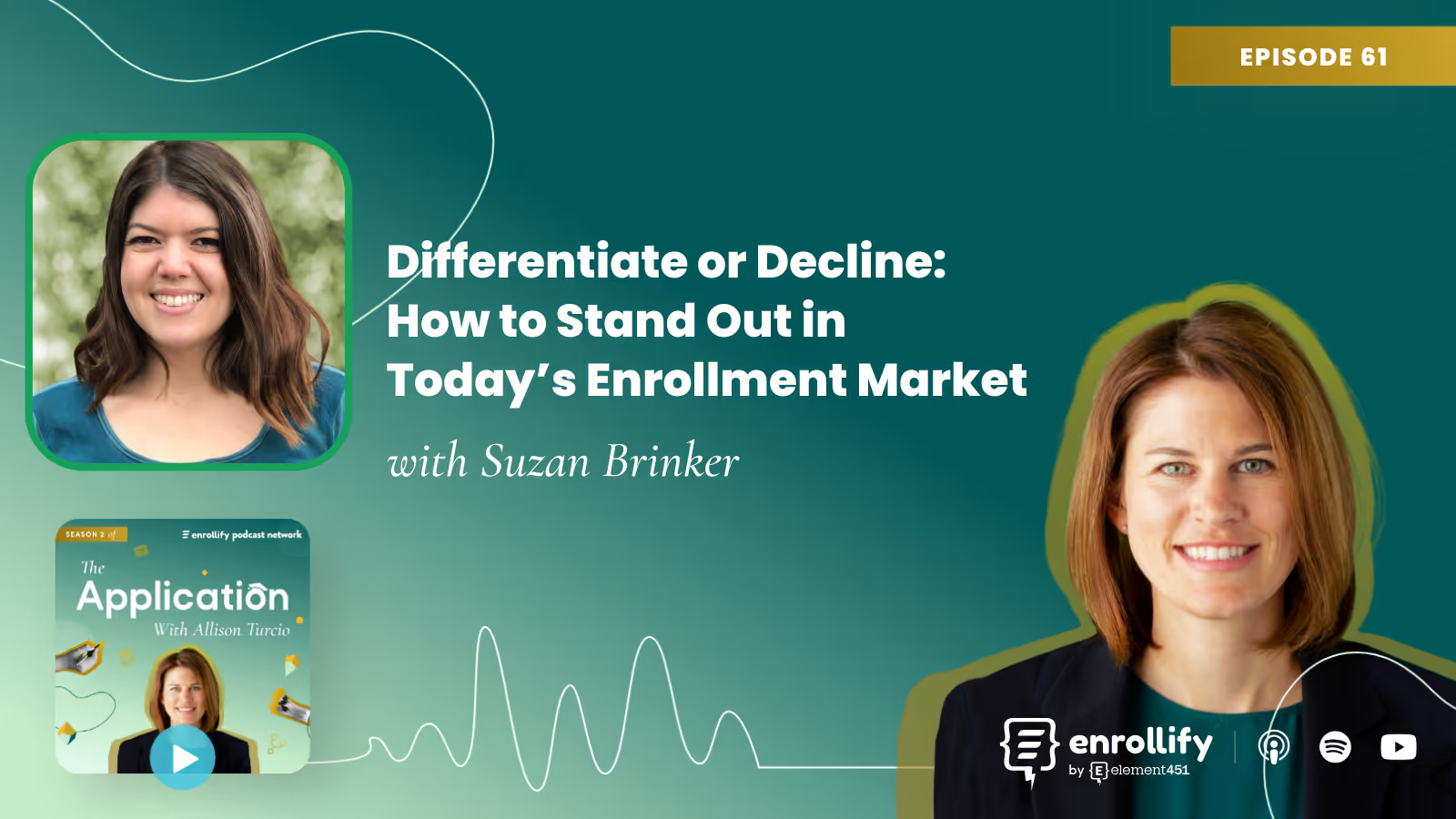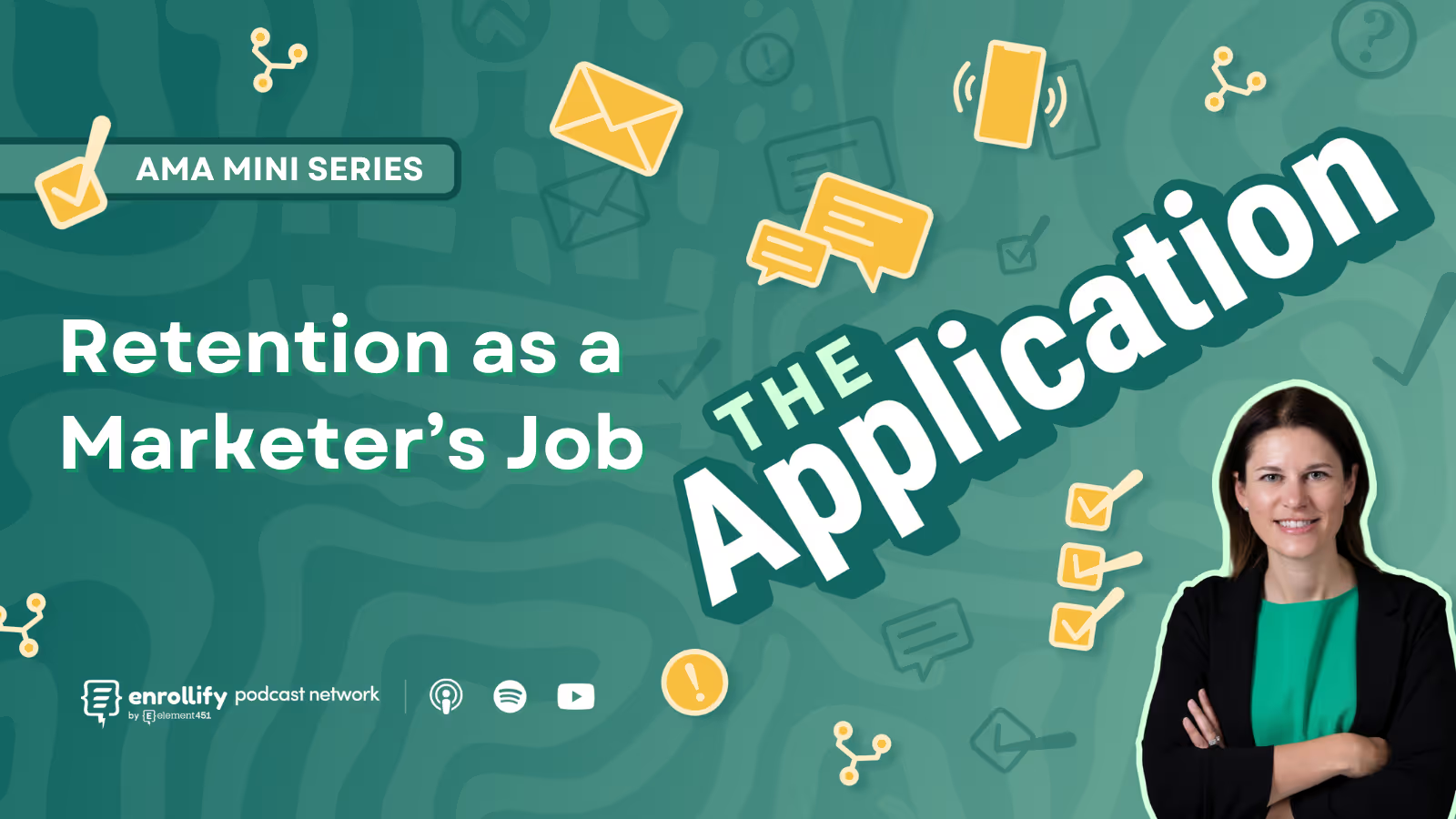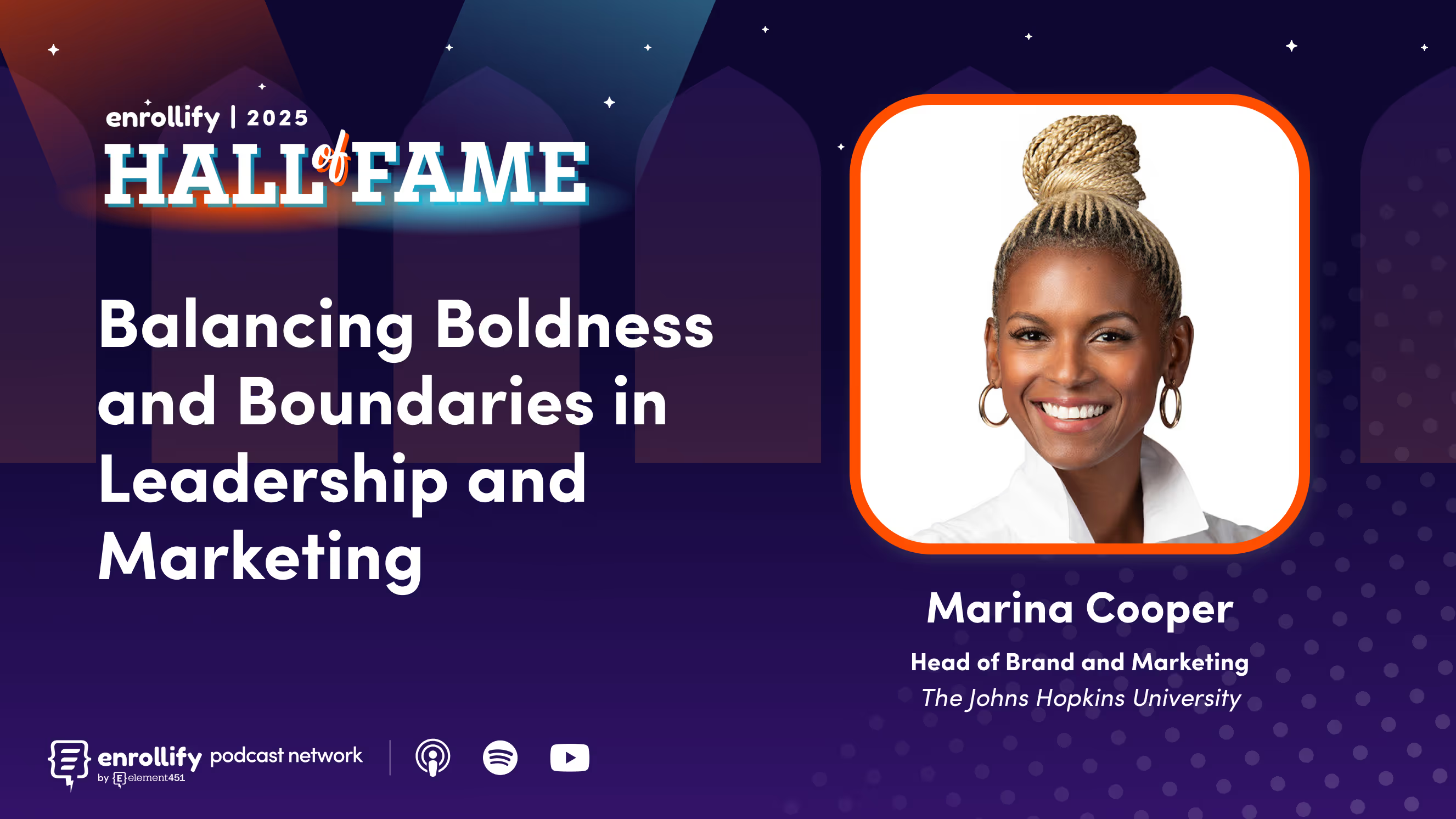About the Episode
Got a story to tell? An innovative idea to share? Fill out our guest nomination form and let's chat!
About the Episode:
Allison is joined by Suzan Brinker, PhD, co-founder and CEO of Viv Higher Education and author of Pass Fail: The Urgent Need for Strategic Leadership in Higher Education. Suzan shares practical strategies and frameworks to help higher ed institutions create authentic differentiation in an increasingly competitive enrollment landscape. This conversation tackles why differentiation is no longer optional, how to get started with a strategy, and what metrics can prove it’s working.
Key “How Tos” You’ll Hear in This Episode:
Leverage Brand Anthropology: Discover how to tell stories rooted in your institution’s history while aligning them with modern audiences.
Build Differentiation Through Storytelling: Move beyond testimonials to create emotional, narrative-driven stories that resonate across the funnel.
Integrate Research, Creative, and Activation: A clear three-step approach to crafting and implementing a differentiation strategy.
Measure Success: Find out which quantitative and qualitative metrics signal that your brand differentiation efforts are working.
Why Differentiation in Higher Ed Marketing is No Longer Optional
With competition for students at an all-time high, simply having great faculty, state-of-the-art facilities, and a strong academic reputation isn’t enough. Students today expect those things as a baseline—they’re looking for something deeper.
Suzan highlights two alarming statistics:
- Higher ed marketing budgets have increased by 500% since 2000, yet many institutions still struggle to stand out.
- 98% of students say colleges and universities look the same.
If institutions don’t invest in differentiation, they risk blending into the background, reducing their chances of converting inquiries into enrollments. This issue is compounded by the rise of the Common App, which makes it easier for students to apply to multiple schools, increasing competition.To succeed, institutions need to craft a brand identity that’s authentic, research-driven, and distinct from competitors—and they must communicate it effectively throughout the entire enrollment funnel.
How Gen Z and Gen Alpha Are Changing Enrollment MarketingYounger generations have completely reshaped how colleges should market themselves. Gen Z and Gen Alpha:
- Start researching colleges as early as eighth grade.
- Demand authenticity and can spot sales-driven messaging from a mile away.
- Expect personalization at scale, meaning institutions must tailor outreach while maintaining efficiency.
Traditional higher ed marketing tactics—such as pushing generic selling points and focusing only on prestige—no longer work. Instead, institutions must tell stories that resonate emotionally and make students feel a personal connection.
The Risks of Relying on Outdated Messaging
Many colleges still lean on messaging that worked 10, 20, or even 30 years ago. However, today’s prospective students have different priorities and expectations. Suzan warns that institutions clinging to old narratives risk:
- Pipeline declines due to failing to capture student interest.
- Loss of competitive edge against institutions that embrace fresh, research-backed branding.
- Disconnection from Gen Z and Gen Alpha, who demand messaging that aligns with their values and experiences.
Institutions must conduct regular market research to understand what their audience actually values—and adjust their branding accordingly.
The Three Key Steps to a Differentiation Strategy
According to Suzan, creating a compelling differentiation strategy requires three essential components:
1. Market Research: Understanding Your Unique Position
To effectively stand out, institutions must analyze:
- Brand Anthropology – What has made your institution unique historically, and how can that be applied to today’s market? (Example: Elon University rebranding from the Fighting Christians to the Phoenix, tying into its legacy of resilience.)
- Labor Demand Analysis – What do employers need from graduates?
- Student Demand Analysis – What are students actively looking for?
- Competitor Analysis – Who are your top five to seven competitors, and why do students choose them over you?
Many institutions don’t have a full understanding of why students don’t choose them. Even simple surveys and enrollment data analysis can provide powerful insights.
2. Creative and Messaging: Bringing Differentiation to Life
Once the research is in place, institutions need to translate insights into compelling creative strategies, including:
- Distinctive messaging that reflects the institution’s unique strengths.
- Emotive storytelling that resonates with students and showcases real, personal experiences.
- Strong visual identity, including authentic photography and video content rather than stock imagery.
- A strategic content journey, ensuring that messaging remains consistent across the entire funnel.
3. Activation: Implementing Differentiation Across Campaigns
The final step is activating the differentiation strategy through marketing efforts, including:
- Digital advertising and lead generation.
- Email nurturing campaigns that extend storytelling beyond the first touchpoint.
- Integrated enrollment marketing efforts that align with admissions.
Suzan stresses that differentiation shouldn’t stop at the ad stage—it must carry through the entire enrollment journey. Too often, colleges attract students with compelling ads but then drop them into generic, transactional email sequences.Performance Marketing and the “1% Better Every Week” RulePerformance marketing is about constantly improving how marketing and admissions efforts drive enrollment. Suzan’s “1% better every week” rule focuses on:
- Establishing baseline performance metrics.
- Testing and iterating on marketing tactics.
- Making data-driven decisions on where to invest resources.
- Aligning marketing and admissions teams to work collaboratively.
For example, her team once assumed that faculty thought leadership content would generate more affordable leads via paid media. However, after closely monitoring data, they found that traditional paid campaigns were more cost-effective. By quickly pivoting, they optimized the marketing budget rather than wasting resources on underperforming strategies.
How to Measure Whether Your Institution is Truly Differentiated
True differentiation isn’t just about creating compelling branding—it’s about measuring impact. Suzan suggests tracking:
- Year-over-year enrollment growth.
- Increases in applications and inquiries.
- Qualitative student feedback, such as surveys asking why students chose or didn’t choose your institution.
- Competitive positioning analysis—how students perceive your institution relative to others.
Many colleges assume they know what makes them unique, but unless they actively seek student feedback, they may be missing critical gaps in their differentiation strategy.
First Steps to Start Differentiating Today
For higher ed professionals looking to build a differentiation strategy, Suzan recommends:
- Identify your top five to seven competitors and analyze why students choose them over you.
- Conduct qualitative research with current students and prospects to understand what resonates.
- Transition from generic testimonials to deep, authentic storytelling.
- Create a content library of at least 20 compelling student stories.
- Align marketing and admissions efforts to ensure storytelling remains consistent across all touchpoints.
Connect With Our Host:
Allison Turcio
https://www.linkedin.com/in/allisonturcio/
https://twitter.com/allisonturcio
About The Enrollify Podcast Network: The Application with Allison Turcio is a part of the Enrollify Podcast Network. If you like this podcast, chances are you’ll like other Enrollify shows, too!
Some of our favorites include Mission Admissions and Visionary Voices: The College President’s Playbook.
Enrollify is made possible by Element451 — the next-generation AI student engagement platform helping institutions create meaningful and personalized interactions with students. Learn more at element451.com.
Attend the 2025 Engage Summit!
The Engage Summit is the premier conference for forward-thinking leaders and practitioners dedicated to exploring the transformative power of AI in education.
Explore the strategies and tools to step into the next generation of student engagement, supercharged by AI. You'll leave ready to deliver the most personalized digital engagement experience every step of the way.
👉🏻 Register now to secure your spot in Charlotte, NC, on June 24-25, 2025!















